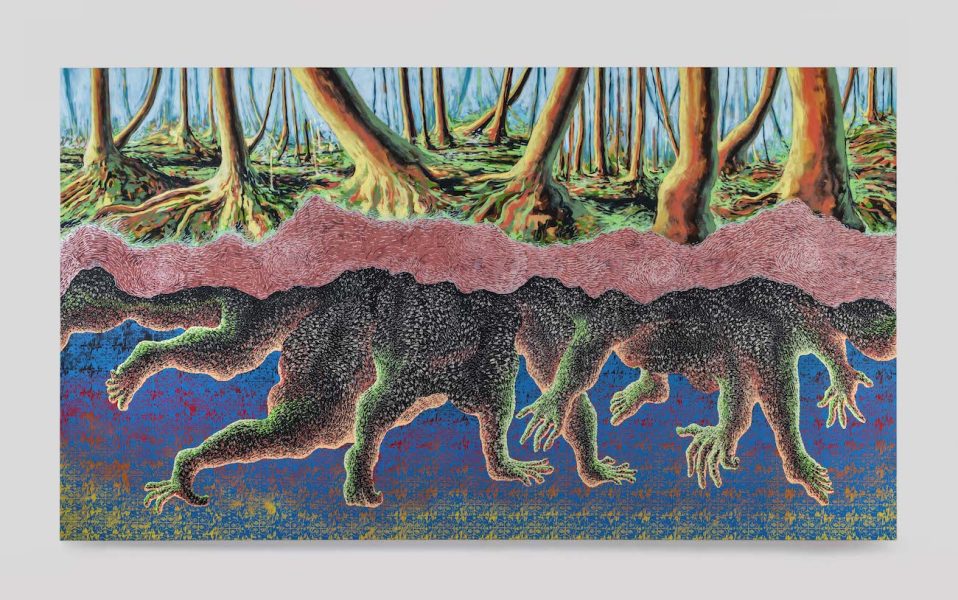
Didier William, Cursed Grounds: Cursed Borders, 2021. Acrylic, oil, ink, and wood carving on panel. 60 × 106 inches (152.4 × 269.3 cm). Private collection. Courtesy of James Fuentes Gallery. © Didier William
(Boston, MA—Sept. 12, 2023) This October, the Institute of Contemporary Art/Boston (ICA) opens Forecast Form: Art in the Caribbean Diaspora, 1990s–Today. This major group exhibition is an innovative rethinking of “Caribbean art,” focusing on art of the Caribbean diaspora and featuring an intergenerational group of 28 artists who live and work across the globe. Challenging conventional ideas about the region, Forecast Form reveals the Caribbean as a place defined not by geography, language, or ethnicity, but by constant exchange, displacement, and movement. The exhibition is organized by the Museum of Contemporary Art Chicago. The ICA’s presentation of Forecast Form is coordinated by Jeffrey De Blois, Associate Curator and Publications Manager, and will be on view from October 5, 2023, through February 25, 2024.
“Forecast Form is a far-reaching, stimulating exhibition of art from the Caribbean and its diaspora. With works by 28 artists from around the world, it is full of new ideas: formal, conceptual and experiential. We’re very excited to share this with audiences from, connected to or new to Caribbean contemporary art,” said Jill Medvedow, the ICA’s Ellen Matilda Poss Director.
“The concept of diaspora—the movement or displacement of people through migration from one location to another—provides a powerful framework for understanding “Caribbean art” in the context of Forecast Form and beyond,” said De Blois. “This concept allows for the artworks in the exhibition to be framed through ideas of movement and transformation, exceeding the limitations of geographic boundaries.”
Forecast Form takes the 1990s, when debates around identity and difference featured front and center, as a cultural backdrop. This decade—a period of profound social, political, and economic transformation globally—also had a major effect on art from the Caribbean, and in the cultural sector gave rise to a Pan-Caribbean art exhibition model that attempted to represent the region’s complex colonial histories through art. In contrast, Forecast Form focuses on the affinities shared between works made by artists who have ties to the region yet hold diverse personal identities, geographies, and histories. Using the weather’s constant movement as a metaphor for analyzing artistic practices, this expansive exhibition reveals new modes of thinking about identity and place. Through a deeply innovative exploration of form, Forecast Form positions the region as a place where the past, the present, and the future meet.
The ICA’s presentation of Forecast Form debuts a new work by Teresita Fernández, Manigua(Mirror) (2023). The word manigua is often used to describe a dense forest or swamp; a chaotic entanglement or an impenetrable place. Inspired by this definition and Wilfredo Lam’s painting, The Jungle (1943), Fernández’s manigua is a space of refuge. Through evocative materials such as charcoal and black sand, and wielding the symbolic power of the palm tree, Manigua(Mirror) conjures an image of a Caribbean landscape as a site of resistance.
Other works in the exhibition include:
This comprehensive group exhibition features 28 artists from across the diaspora: Candida Alvarez, María Magdalena Campos-Pons, Donna Conlon and Jonathan Harker, Christopher Cozier, Julien Creuzet, Maksaens Denis, Peter Doig, Jeannette Ehlers, Alia Farid, Teresita Fernández, Rafael Ferrer, Denzil Forrester, Joscelyn Gardner, Felix Gonzalez-Torres, Deborah Jack, Engel Leonardo, Daniel Lind-Ramos, Suchitra Mattai, Ana Mendieta, Lorraine O’Grady, Ebony G. Patterson, Keith Piper, Freddy Rodríguez, Zilia Sánchez, Adán Vallecillo, Cosmo Whyte, and Didier William.
The exhibition is accompanied by a substantial 288-page catalogue featuring groundbreaking scholarship as well as extensive plate sections reproducing exhibition artworks.
About the ICA
Since its founding in 1936, the ICA has shared the pleasures of reflection, inspiration, imagination, and provocation that contemporary art offers with its audiences. A museum at the intersection of contemporary art and civic life, the ICA has advanced a bold vision for amplifying the artist’s voice and expanding the museum’s role as educator, incubator, and convener. Its exhibitions, performances, and educational programs provide access to the breadth and diversity of contemporary art, artists, and the creative process, inviting audiences of all ages and backgrounds to participate in the excitement of new art and ideas. The ICA is located at 25 Harbor Shore Drive, Boston, MA, 02210. The Watershed is located at 256 Marginal Street, East Boston, MA 02128. For more information, call 617-478-3100 or visit our website at icaboston.org. Follow the ICA on Facebook, Instagram, and TikTok.
Media Contact
Theresa Romualdez, press@icaboston.org
Credits
Forecast Form: Art in the Caribbean Diaspora, 1990s–Today was organized by Museum of Contemporary Art Chicago.
Major support for Forecast Form: Art in the Caribbean Diaspora, 1990s–Today was provided by The Andy Warhol Foundation for the Visual Arts.

The exhibition is curated by Carla Acevedo-Yates, Marilyn and Larry Fields Curator, with Iris Colburn, Curatorial Assistant, Isabel Casso, former Susman Curatorial Fellow, and Nolan Jimbo, Susman Curatorial Fellow.
The ICA/Boston presentation is coordinated by Jeffrey De Blois, Associate Curator and Publications Manager.
With warmest thanks, we gratefully acknowledge the generosity of the ICA’s Avant Guardian Society in making this exhibition possible.